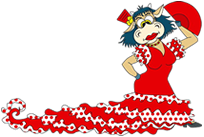-
Wiki
-
Another word for teh castanets.
-
A clap is the sound made by striking together two flat surfaces, as in the body parts of humans or animals. Humans clap with the palms of their hands, often in a constant drone to express appreciation or approval (see applause), but also in rhythm to match sounds in music and dance. Seals are among the animals that clap.
Some people slap the back of one hand into the palm of the other hand to signify urgency or enthusiasm; others consider it uncouth
Perhaps the best-known koan involves (at least superficially) consideration of the act of clapping: "What is the sound of one hand clapping?"
Clapping is used as a percussion element in many forms of music, for example in Flamenco and Gospel music. -
Flamenco music styles are called palos in Spanish. There are over 50 different palos flamenco, although some of them are rarely performed. A palo can be defined as musical form of flamenco. Flamenco songs are classified into palos based on several musical and non-musical criteria such as its basic rhythmic pattern, mode, chord progression, form of the stanza, or geographic origin. The rhythmic patterns of the palos are also often called compás. A compás (the Spanish normal word for either time signature or bar) is characterised by a recurring pattern of beats and accents.
-
For one reason or another, a power cut was the end of these dances or the smoke of the chimney filled the room.
-
Each movement of the dance forming a choreography.
-
Commotion caused by some dances and songs.
-
Organizations formed like associations by amateurs of the flamenco art, to excite and spread the singing, the dancing and the flamenco toque. Born in the sixties in Andalusia, extendiing all over Spain and foreign countries. The main theme discussed in the Peñas Flamencas is the flamenco art.
-
The Petenera is a flamenco palo in a 12-beat metre, with strong beats distributed as follows: [1][2][3][4][5][6][7][8][9][10][11][12]. It is therefore identical with the 16th century Spanish dances zarabanda and the jácara.
The lyrics are in 4-line stanzas.
It is believed to be a very old style of song, as it was already mentioned by writer Serafín Estébanez Calderón in the mid 19th century, and the adherence to the rhythm of the old zarabanda seems to confirm its age. -
Guitare technique of the right hand to realize a melody with the following fingers: index finger and finger ring (someones realize this technique with three fingers).
-
Name for the click/snap produced with the fingers.
-
Old name for the seguiriyas folk songs.
-
Polo is the name of a flamenco palo or musical form. There is only one known song in this palo, which is extremely similar to another palo called caña, and its guitar accompaniment, like the caña, shares its rhythm and motifs with soleá. Both the caña and polo share the same musical mode. In fact, the polo has usually been considered as a derivation of the caña. To complete the singing of the polo, singers usually sing a stanza in the palo of soleá, generally a the style called soleá apolá.
Although nowadays, only one song is known for the polo, known as polo natural, past writers also mention another polo, called polo de Tobalo, which has probably been lost.
As to the metre and musical mode, they are the same as for the soleá, that is 12-beat metre (or alternating 3/4 and 6/8).
The guitar accompaniment and falsetas are also inspired by the soleá, although some special arpeggios are included after the second line of each section ("con catorce" and "y viva el polo") and during the singing of the melismas. It is always accompanied in the guitar chord position of E for the tonic. Musicologist Hipólito Rossy stated that the song was in [major mode] and 3-beat metre (Rossy [1966] 1998), but it is obvious that he was not very familiar with this palo, as all recordings show the typical soleá rhythm and Phrygian mode. He might have been influenced by the recording of singer Jacinto Almadén, in which guitarist Perico el del Lunar certainly uses some chords insinuating the major mode.
Both the caña and the polo seem to have enjoyed great success and were considered the finest type of flamenco song at the beginning of the 19th century. Serafín Estébanez Calderón, in his book from 1847 Escenas andaluzas (Andalusian Scenes), mentioned famous singer El Planeta (the protagonist in one of the scenes), as "King of both polos". He also assured that the polo was difficult to sing and that it was derived from the caña and mentions the polo de Tobalo. The polo is widely mentioned in the literature of the 19th century. Most important singers at the time included it in their repertoire, up to the times of Antonio Chacón, who is reported to be one of the latest great performers of this song.Although historic sources mention two or more polos, only one variety is known for sure to have survived to our days: the polo natural. Singer Pepe de la Matrona recorded a version of the polo Tobalo at the end of the 1969s, but the authenticity of this recorded version has been put in doubt by several critics on the grounds that he could never explain who he had heard it from (Álvarez Caballero 1998).
The only old recording with the title of polo, prior to its rediscovery in the 1950s, was made by La Rubia and it resembles the caña even more than the usual version of the polo natural. In 1960, at the time of reappraisal of traditional cante, the polo natural was recorded by Jacinto Almadén (also known as "El Niño de Almadén"), in the Antología del cante flamenco compiled by guitarist Perico el del Lunar and flamencologist Tomás Andrade de Silva.
-
When the tonality of the flamenco music is in Mi Major, Alegrias 3 = Sol Major, Soleares by 3 pro arriba = Sol modal.
-
When the tonality of the flamenco music is in La Major.
-
Song of the region of Asturias, music and chords coming from the folklore from Asturias.
-
Songs to promote and sell products.
-
On the guitar lid, place where we tie the end of the strings.
-
The music have beats or tidy and regular impulse. We call them beats.












